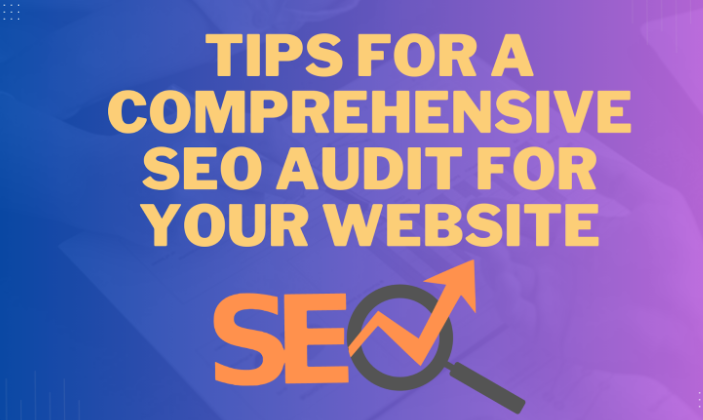Tips for a Comprehensive SEO Audit for Your Website
Performing a comprehensive SEO audit is a crucial step in optimizing your website for search engines and improving its overall performance. SEO, short for Search Engine Optimization, involves a series of strategies and techniques to enhance a website’s visibility and ranking in search engine results pages (SERPs). Conducting an SEO audit allows you to identify areas for improvement, fix issues, and capitalize on opportunities to boost organic traffic and attract potential customers. In this article, we’ll outline a step-by-step guide on how to perform a comprehensive SEO audit for your website. Add two more lines in the paragraph
By following these tips, you can gain valuable insights into your website’s SEO health and create a roadmap for sustainable growth. Remember that an SEO audit is an ongoing process, and regularly reviewing and optimizing your website will help you stay ahead in the ever-evolving digital landscape. So, let’s dive into the key elements of a comprehensive SEO audit and unlock the potential to elevate your website’s search engine performance.
-
Set Clear Objectives:
Defining clear objectives is the foundational step of any successful SEO audit. Ask yourself what you want to achieve with your SEO efforts. Are you aiming to increase organic traffic to your website, boost sales and conversions, enhance user engagement and time on site, or improve your website’s visibility in search engine results? Knowing your goals will help you focus on the right areas during the audit and measure the success of your efforts accurately.
Thanks to Arnaud, CMO Assistant of LeanLaw
-
Analyze Website Structure and Navigation:
A well-structured website with intuitive navigation is not only beneficial for users but also helps search engines understand your content better. During this step:
- Hierarchy: Ensure your website follows a logical hierarchy with a clear organization of categories and subcategories. This helps users and search engines navigate through your site efficiently.
- User-Friendly URLs: Check that your URLs are clean, descriptive, and readable, containing relevant keywords. Avoid using long strings of numbers or symbols in your URLs.
- Broken Links: Identify and fix any broken links or 404 errors on your website. Broken links can frustrate users and negatively impact your SEO rankings.
- Internal Linking: Assess your internal linking structure to ensure that important pages receive enough link equity. Proper internal linking can help spread authority throughout your website.
Thanks to Jessica Shee from iBoysoft
-
Evaluate On-Page SEO Elements:
On-page SEO elements play a crucial role in communicating the relevance and content of your web pages to search engines. Analyze each page of your website for the following elements:
- Title Tags: Craft unique and descriptive title tags for each page, incorporating relevant keywords. Keep the titles concise (around 50-60 characters) to avoid truncation in search results.
- Meta Descriptions: The meta description should be 150-160 characters that clearly summarize what’s in the blog. However, creating such a small summary of a lengthy blog can be difficult. So, you can use an online summarizing tool to get the best lines from it.
- Headings: Use heading tags (H1, H2, H3, etc.) to structure your content. Headings provide a hierarchical order to your page and make it easier for both users and search engines to understand the content.
- Content Quality: Assess the quality and relevance of your website’s content. High-quality, informative, and engaging content is more likely to attract and retain visitors, encouraging them to spend more time on your site.
- Keyword Usage: Analyze the usage of target keywords throughout your content. Ensure that keywords are used naturally and avoid overstuffing them, as it may lead to keyword cannibalization or keyword spamming penalties.
Thanks to Kyle Garcia from Seoauditcompany
-
Review Technical SEO Aspects:
Technical SEO involves optimizing various technical aspects of your website to make it more accessible and understandable to search engines. During this phase:
- Site Speed: Check your website’s loading speed using tools like Google PageSpeed Insights. Optimize images, minify CSS and JavaScript, and leverage browser caching to improve site speed, which is a crucial ranking factor.
- Mobile-Friendliness: With mobile devices accounting for a significant portion of web traffic, ensure your website is responsive and displays correctly on various devices.
- Robots.txt: Review your website’s robots.txt file to ensure it’s correctly set up. This file instructs search engine crawlers on which pages to index and which ones to ignore.
- XML Sitemap: Confirm that your XML sitemap is up-to-date and contains all relevant URLs. Submit the sitemap to search engines to aid in the crawling and indexing process.
- HTTPS and Security: Implement an SSL certificate (HTTPS) to encrypt data transmitted between your website and users, providing a secure browsing experience. Google considers HTTPS as a ranking signal.
Thanks to John Chandler, SEO Consultant at Humbletrail
-
Assess Website Backlink Profile:
Backlinks are vital for SEO as they signal to search engines the authority and relevance of your website. Conduct a backlink audit to:
- Identify Quality Backlinks: Identify high-quality and authoritative backlinks pointing to your website. Quality backlinks can positively impact your rankings.
- Remove Toxic Backlinks: Disavow any toxic or spammy backlinks that could harm your website’s reputation. Toxic backlinks can result in search engine penalties.
Thanks to Olivia Parker, Chief Marketing Officer (CMO) at Better DaysTreatment
-
Check Website Analytics:
Website analytics provide valuable insights into your website’s performance and user behavior. Use tools like Google Analytics to:
- Analyze Traffic Sources: Understand where your website traffic is coming from. This information can help you focus on channels that drive the most relevant traffic.
- User Behavior: Evaluate metrics like bounce rate, time on site, and page views per session to understand how visitors interact with your site.
- Conversion Rates: Monitor conversion rates to track the effectiveness of your SEO efforts in driving desired actions (e.g., form submissions, purchases).
Thanks to Alan Perkins Co-Founder at RadialZone.com
-
Local SEO Audit (If Applicable):
If your business has a local presence, a local SEO audit is essential to improve visibility in local searches. During this audit:
- NAP Consistency: Ensure that your business Name, Address, and Phone number (NAP) information is consistent across all online platforms and directories.
- Google My Business (GMB): Claim and optimize your Google My Business listing. Complete all relevant information, including operating hours, categories, and images, to improve local search visibility.
Thanks to Hamza G, Head of Marketing of Moneygeniustips
-
Analyze Competitors:
Understanding your competitors’ strategies and performance can provide valuable insights for enhancing your SEO efforts. During competitor analysis:
- Keywords: Identify keywords and phrases your competitors are targeting. This can help you discover new keyword opportunities.
- Backlinks: Analyze your competitors’ backlink profiles to find potential linking opportunities for your website.
- Content: Evaluate the type and quality of content your competitors are producing. This can inspire your content marketing strategy.
Thanks to Etienne Marais, Director at Events Hospitality
-
Create an Action Plan:
After completing the audit, compile all the identified issues, areas for improvement, and potential opportunities into an action plan. Prioritize tasks based on their impact and feasibility. Your action plan should be comprehensive and detailed, outlining steps to address technical, on-page, and off-page SEO elements.
-
Monitor Progress and Adapt:
SEO is an ongoing process, and regular monitoring is essential to measure the success of your efforts. Keep a close eye on key performance indicators (KPIs) and adapt your strategies as needed. Stay informed about the latest SEO trends and algorithm updates to maintain a competitive edge in the ever-evolving digital landscape.
Conclusion:
Conducting a comprehensive SEO audit is essential for any website looking to improve its online visibility and search rankings. By following the steps outlined in this article, you’ll be well-equipped to identify areas for improvement, optimize your site, and enhance your overall SEO performance. Remember that SEO is a continuous journey, and staying proactive in your efforts will lead to long-term success for your website. Write two more lines to this conclusion.
Consistently monitoring and adapting your SEO strategies based on evolving trends and search engine algorithms will help you maintain a competitive edge in the digital landscape. Embracing a holistic approach to SEO and implementing the necessary changes will ultimately drive organic traffic, increase user engagement, and position your website for sustained success in the online realm.




